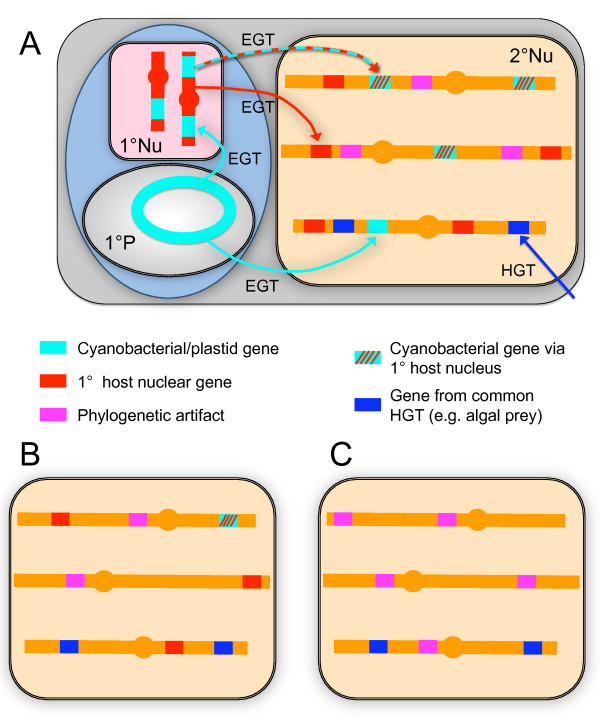Figure 1.
Endosymbiotic gene transfer and other potential explanations for finding "algal" genes in any given genome. A. Depicts the complexity of genome remodeling in typical secondary endosymbioses, particularly the massive transfer of genes from the primary plastid alga to its new host cell nucleus. Most genes from the original primary (cyanobacterial) plastid (1P) endosymbiont already made their way into the primary host nucleus (1Nu) via EGT. These genes are transferred, in turn, to the secondary host's nucleus (2Nu), if they are essential for plastid function. Some genes still present in the primary plastid genome could be transferred directly to the secondary host nucleus. Genes from the primary alga's nucleus that are not related to plastid function can be transferred to the secondary host, either replacing original homologs or adding novel functions to the host's metabolism. In addition, for as long as the secondary host was or remains phagotrophic, many additional "algal" genes could accumulate by more typical HGT from prey items. Finally, an unknown fraction of genes in the secondary host's genome are recovered with algal clades because of phylogenetic, tree-building artefacts. For more extensive reviews of eukaryotic EGT/HGT, see references [25,63]. B. Expectation if the secondary plastid is lost during the subsequent evolution of the algal genome shown in panel A. "Algal" genes directly related to plastid function are likely to accumulate null mutations and be lost, but many that were adapted to functions unrelated to photosynthesis should remain under strong purifying selection and be retained in the genome. These genes could represent a "footprint" of the past endosymbiosis, if they provide a significantly stronger phylogenetic signal than is expected from other known sources of tree-building conflicts, such as common HGT or phylogenetic artefacts. C. Panel shows a nucleus containing a comparable number of genes that cluster with algal sequences in phylogenetic analyses, but in this case most represent phylogenetic artefacts and none are from EGT. It is critical that investigations of EGT be designed to test explicitly among alternative, plausible explanations for the presence "algal" genes.

